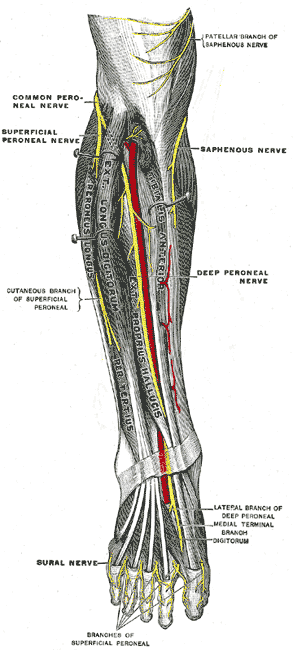
Anatomy
Lower Limb
A 28 year old man presents to hospital having injured his leg playing football. X-ray demonstrates fractures of both the tibia and fibula. The patient demonstrates foot drop, but has normal eversion of the foot. Which of the following nerves has most likely been injured:
Answer:
Foot drop (loss of dorsiflexion) results from paralysis of the anterior leg muscles, innervated by the deep fibular nerve. Eversion is produced primarily by the fibularis longus and brevis, innervated by the superficial fibular nerve. Eversion in this case is normal, thus the superficial fibular nerve is unaffected and therefore the common fibular nerve is intact. The sural nerve is a cutaneous branch of the tibial nerve. The tibial nerve innervates the posterior leg muscles, responsible for plantarflexion of the foot and flexion of the toes.Deep Fibular Nerve
Anatomy / Lower Limb / Anterior Leg / Innervation of Lower Limb
Last Updated: 6th December 2020
The deep fibular nerve is a branch of the common fibular nerve.
Table: Anatomical Overview of the Deep Fibular Nerve
| Nerve | Deep Fibular |
|---|---|
| Nerve roots | L4 -L5 |
| Motor supply | Anterior compartment of leg |
| Sensory supply | Webspace between 1st and 2nd toes |
| Injury | Motor Loss: Loss of dorsiflexion of ankle and extension of toes, foot drop with high-stepping gait, weakness of foot inversion
Sensory Loss: Loss of sensation over webspace between 1st and 2nd toes |
Anatomical Course

Deep Fibular Nerve. (Image by Henry Vandyke Carter [Public domain], via Wikimedia Commons)
Function
It innervates the anterior leg (tibialis anterior, extensor hallucis longus, extensor digitorum longus, fibularis tertius) and the dorsal intrinsic muscles of the foot. It supplies skin over the webspace between the 1st and 2nd toes.
Table: Motor Supply of the Deep Fibular Nerve
| Muscle | Function |
|---|---|
| Tibialis anterior | Dorsiflexion and inversion of foot, support of medial arch of foot |
| Extensor hallucis longus | Extension of great toe and dorsiflexion of foot |
| Extensor digitorum longus | Extension of lateral four toes and dorsiflexion of foot |
| Fibularis tertius | Dorsiflexion and eversion of foot |
![Modified by FRCEM Success. Original by Henry Vandyke Carter [Public domain], via Wikimedia Commons](https://mrcemsuccess.com/wp-content/uploads/2017/01/Cutaneous-Innervation-Leg.png)
Cutaneous Innervation of Lower Limb. (Image modified by FRCEM Success. Original by Henry Vandyke Carter [Public domain], via Wikimedia Commons)
Report A Problem
Is there something wrong with this question? Let us know and we’ll fix it as soon as possible.
Loading Form...
- Biochemistry
- Blood Gases
- Haematology
| Biochemistry | Normal Value |
|---|---|
| Sodium | 135 – 145 mmol/l |
| Potassium | 3.0 – 4.5 mmol/l |
| Urea | 2.5 – 7.5 mmol/l |
| Glucose | 3.5 – 5.0 mmol/l |
| Creatinine | 35 – 135 μmol/l |
| Alanine Aminotransferase (ALT) | 5 – 35 U/l |
| Gamma-glutamyl Transferase (GGT) | < 65 U/l |
| Alkaline Phosphatase (ALP) | 30 – 135 U/l |
| Aspartate Aminotransferase (AST) | < 40 U/l |
| Total Protein | 60 – 80 g/l |
| Albumin | 35 – 50 g/l |
| Globulin | 2.4 – 3.5 g/dl |
| Amylase | < 70 U/l |
| Total Bilirubin | 3 – 17 μmol/l |
| Calcium | 2.1 – 2.5 mmol/l |
| Chloride | 95 – 105 mmol/l |
| Phosphate | 0.8 – 1.4 mmol/l |
| Haematology | Normal Value |
|---|---|
| Haemoglobin | 11.5 – 16.6 g/dl |
| White Blood Cells | 4.0 – 11.0 x 109/l |
| Platelets | 150 – 450 x 109/l |
| MCV | 80 – 96 fl |
| MCHC | 32 – 36 g/dl |
| Neutrophils | 2.0 – 7.5 x 109/l |
| Lymphocytes | 1.5 – 4.0 x 109/l |
| Monocytes | 0.3 – 1.0 x 109/l |
| Eosinophils | 0.1 – 0.5 x 109/l |
| Basophils | < 0.2 x 109/l |
| Reticulocytes | < 2% |
| Haematocrit | 0.35 – 0.49 |
| Red Cell Distribution Width | 11 – 15% |
| Blood Gases | Normal Value |
|---|---|
| pH | 7.35 – 7.45 |
| pO2 | 11 – 14 kPa |
| pCO2 | 4.5 – 6.0 kPa |
| Base Excess | -2 – +2 mmol/l |
| Bicarbonate | 24 – 30 mmol/l |
| Lactate | < 2 mmol/l |

